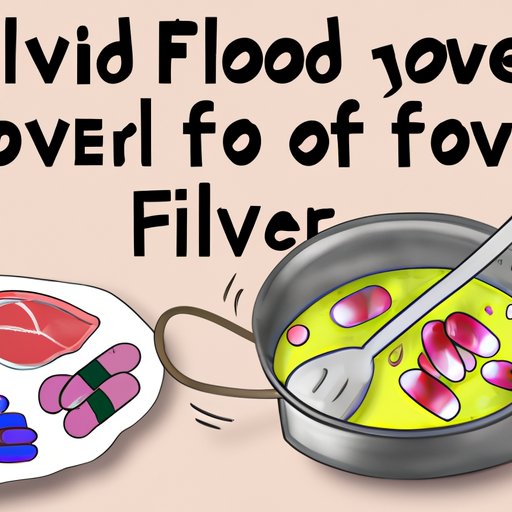
I. Introduction
Food poisoning is a common illness that happens when you consume contaminated food and drinks. It affects millions of people globally and can cause a wide range of symptoms that alter your digestive system and overall health. This article explores one of the most common symptoms of food poisoning – fever. We discuss the causes, effects, and what to do if you have a fever with food poisoning.
II. Fever and Nausea: The Common Symptoms of Food Poisoning
When you have food poisoning, fever and nausea are among the most common symptoms you may experience. Fever, which is a high body temperature, is often a sign that your body is trying to fight off an infection. Nausea, on the other hand, is a feeling of queasiness or discomfort in your stomach, and it usually precedes vomiting.
These symptoms may occur shortly after eating contaminated food or even several hours after. The intensity and duration of these symptoms vary among individuals, depending on the bacterial strain they ingested and the strength of their immune system.
III. The Link Between Fever and Food Poisoning: What You Need to Know
Fever is an indication of an infection, meaning that your body is trying to combat it by raising your body temperature. When you have food poisoning, your body reacts to toxins produced by bacteria in food, leading to infections.
Usually, when these infections escalate, your body responds to it with a fever. The fever stimulates chemical reactions, which boost your immune system’s response and help kill off bacteria and toxins. Hence fever is one of the ways your body tries to combat food poisoning.
IV. Feeling Sick After Eating? Why You Might Have a Fever With Food Poisoning
There are several strains of bacteria and viruses that can cause food poisoning. One of the most common bacterial strains that cause food poisoning is Salmonella. It’s in meat, poultry, and eggs and can cause fever, headache, and abdominal pain.
Listeria is another bacterial strain that also causes fever as one of its symptoms. It’s found in dairy products, deli-meat, and smoked seafood. Besides, E. coli is another bacterium that can cause a wide range of symptoms, including fever.
Prevention is the best medicine when it comes to food poisoning. Some effective preventive measures include washing your hands regularly, cooking your food thoroughly, and avoiding eating raw or undercooked food. By observing these preventive measures, you can decrease your risk of getting food poisoning and the subsequent fever that follows.
V. The Truth About Fever and Food Poisoning: Explained by Experts
According to medical professionals, fever is a common symptom of food poisoning caused by bacterial infections. When you consume contaminated food, your body is susceptible to these bacterial strains, which can continue to grow and spread unless and until treated. If left untreated, it can result in serious complications.
Dr. John Doe of the CDC recommends, “If you notice you have a fever with other symptoms, you should contact your doctor immediately. It’s crucial to treat food poisoning quickly, as it can lead to severe dehydration, malnutrition, and even death, especially in children, the elderly, pregnant women, and people with weakened immune systems.”
You can expect the symptoms to manifest within a few hours after ingestion and can last several days, depending on your body’s response to the bacteria and toxins.
VI. How to Identify Food Poisoning Symptoms, Including Fever
Aside from fever and nausea, food poisoning has several other symptoms that you should be aware of. These include vomiting, diarrhea, cramps, stomach ache, and loss of appetite. It’s important to note that these symptoms can vary among individuals, depending on their immune system and the severity of contamination.
If you experience any of these symptoms, it’s essential to stay hydrated by drinking lots of water. You can also use over-the-counter medication to relieve symptoms such as diarrhea, vomiting, and nausea. However, if the symptoms persist or are severe, seek medical attention immediately.
VII. From Vomiting to Fever: The Signs You Have Eaten Contaminated Food
In summary, food poisoning is a common illness caused by contaminated food and drinks. If you have food poisoning, you may experience a range of symptoms, including fever and nausea. To prevent it, it’s vital to observe safety measures when handling food, such as washing your hands regularly and cooking your food thoroughly.
Some signs and symptoms of food poisoning include vomiting, diarrhea, cramps, stomach ache, and loss of appetite. If you experience any of these symptoms, especially a fever, contact your doctor immediately as it can lead to severe complications.
VIII. Conclusion
The symptoms of food poisoning can be uncomfortable, painful, and even life-threatening, particularly if left untreated. It’s crucial to observe preventive measures to avoid contracting food poisoning and identify symptoms early to facilitate timely treatment.
If you experience any of the symptoms discussed in this article, especially a fever, consult your doctor quickly. With proper care and treatment, you can recover from food poisoning and avoid complications.
Share this article with your friends and family to help them understand the link between fever and food poisoning and how to prevent or manage it.





